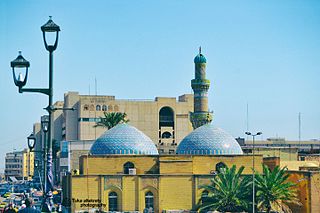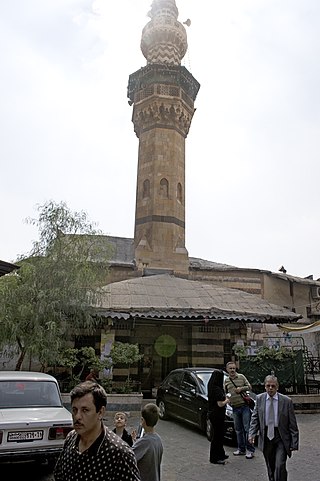Related Research Articles
Shaykh 'Abd al-Ghani ibn Isma′il al-Nabulsi (an-Nabalusi), was an eminent Sunni Muslim scholar, poet, and author on works about Sufism, ethnography and agriculture.

The Sulaymaniyya Takiyya is a takiyya in Damascus, Syria, located on the right bank of the Barada River. Commissioned by the Ottoman sultan Suleiman the Magnificent, the western building of the complex was built, following the plans of Mimar Sinan, between 1554 and 1559. Another building was added eastwards from it in 1566 to be used as a madrasa.

The Salimiyya Madrasa is a 16th-century madrasa in Damascus, Syria. It is part of the Sulaymaniyya Takiyya, started under the Ottoman sultan Süleyman I.

The old city of Damascus is the historic city centre of Damascus, Syria. The old city, which is one of the oldest continuously inhabited cities in the world, contains numerous archaeological sites, including some historical churches and mosques. Many cultures have left their mark, especially Hellenistic, Roman, Byzantine and Islamic. In 1979, the historical center of the city, surrounded by walls of Roman era, was declared a World Heritage Site by UNESCO. In June 2013, UNESCO included all Syrian sites on the list of World Heritage in Danger to warn of the risks to which they are exposed because of the Syrian Civil War.
Qara or Kara is a Syrian city in the An-Nabek District of the Rif Dimashq Governorate. It is located between the Qalamoun Mountains and the Eastern Lebanon mountains range, 95 kilometres (59 mi) north of the capital Damascus on the road to the city of Homs. According to the Syria Central Bureau of Statistics (CBS), Qara had a population of 12,508 in the 2004 census. Its inhabitants are mostly Sunni Muslims and Greek Orthodox and Catholic Christians.

The Murad Pasha Mosque is an early Ottoman-era mosque and mausoleum in Damascus, Syria, located in the Suwayqa sector of the Al-Midan quarter. The mosque was erected and named after Murad Pasha, who served as the Ottoman governor ("wali") of Damascus between 1568-1569. The mosque was built in 1568. The mosque is also known as the Naqshbandi Mosque after the Naqshbandi sufi order which it served as a center for.

Mamluk architecture was the architectural style that developed under the Mamluk Sultanate (1250–1517), which ruled over Egypt, the Levant, and the Hijaz from their capital, Cairo. Despite their often tumultuous internal politics, the Mamluk sultans were prolific patrons of architecture and contributed enormously to the fabric of historic Cairo. The Mamluk period, particularly in the 14th century, oversaw the peak of Cairo's power and prosperity. Their architecture also appears in cities such as Damascus, Jerusalem, Aleppo, Tripoli, and Medina.

Amir al-hajj was the position and title given to the commander of the annual Hajj pilgrim caravan by successive Muslim empires, from the 7th century until the 20th century. Since the Abbasid period, there were two main caravans, one departing from Damascus and the other from Cairo. Each of the two annual caravans was assigned an amir al-hajj whose main duties were securing funds and provisions for the caravan, and protecting it along the desert route to the Muslim holy cities of Mecca and Medina in the Hejaz.
Yusuf Shihab (1748–1790) was the autonomous emir of Mount Lebanon between 1770 and 1789. He was the fifth consecutive member of the Shihab dynasty to govern Mount Lebanon.
Sulayman Pasha al-Adil was the Ottoman governor of Sidon Eyalet between 1805 and 1819, ruling from his Acre headquarters. He also simultaneously served as governor of Damascus Eyalet between 1810 and 1812. He was a mamluk of his predecessor, Jazzar Pasha. His rule was associated with decentralization, a reduction of Acre's military, and limits to his predecessors' cotton monopoly. Moreover, he oversaw a policy of non-interference with his deputy governors, such as Muhammad Abu-Nabbut and Mustafa Agha Barbar, and diplomacy with the autonomous sheikhs of the various Levantine regions where he held authority, including Emir Bashir Shihab II and Musa Bey Tuqan. He exercised control over his domain largely through depending on the loyalty of his deputies, who also had been mamluks of Jazzar. In effect, Sulayman Pasha presided over the world's last functioning mamluk system.

The Mosque-Madrasa of al-Asifyah is a complex of mosque and madrasa located near the riverbank of Tigris, in Baghdad, Iraq. The mosque and its associated complex including school buildings, old courts and other former government buildings, and a palace are contained within a 7.57-hectare (18.7-acre) site alongside the banks of the Tigris that forms part of a tentative UNESCO World Heritage Site list.

Ottoman architecture in Egypt, during the period after the Ottoman conquest in 1517, continued the traditions of earlier Mamluk architecture but was influenced by the architecture of the Ottoman Empire. Important new features introduced into local architecture included the pencil-style Ottoman minaret, central-domed mosques, new tile decoration and other characteristics of Ottoman architecture. Architectural patronage was reduced in scale compared to previous periods, as Egypt became an Ottoman province instead of the center of an empire. One of the most common types of building erected in Cairo during this period is the sabil-kuttab.
Khidr Bey or Khidr Beg was an Ottoman Hanafi-Maturidi scholar and poet of the 9th/15th century, and the first kadi (qadi) of Istanbul. The unique source for his biography is the Arabic original of al-Shaqa'iq al-Nu'maniyya by Tash-Kopru-Zade.

Classical Ottoman architecture is a period in Ottoman architecture generally including the 16th and 17th centuries. The period is most strongly associated with the works of Mimar Sinan, who was Chief Court Architect under three sultans between 1538 and 1588. The start of the period also coincided with the long reign of Suleiman the Magnificent, which is recognized as the apogee of Ottoman political and cultural development, with extensive patronage in art and architecture by the sultan, his family, and his high-ranking officials.

Tahir al-Jaza'iri was a 19th century Syrian Muslim scholar and educational reformer and a great scholar of Tafsīr, Ḥadīth, Fiqh, Uṣūl, history and the Arabic language.
Najm al-Din Muhammad al-Ghazzi was a scholar based in Damascus during Ottoman rule. He is best known for his biographical dictionaries. The biographies were mainly about the notables of Syria and, to a lesser extent, those of Egypt and other parts of the Ottoman Empire in the 16th and 17th centuries.

The Salimiyya Takiyya is a takiyya in as-Salihiyya, Damascus.
Kaplan Mataraci Pasha was the Ottoman governor of Sidon in 1698–1703.

Bab al-Sheikh is an old neighborhood in the Rusafa side of Baghdad, Iraq. It is notable for being the location of the mausoleum of Sufi Sheikh Abd al-Qadir al-Gilani, founder of the Qadiriyya Order. The area is located in Bab al-Sharqi and next to al-Khilani Square.
References
- ↑ Sirriyeh 2005, p. 155, note 4.
- ↑ Rihawi 1977, p. 73.
- ↑ Sirriyeh 2005, p. 4.